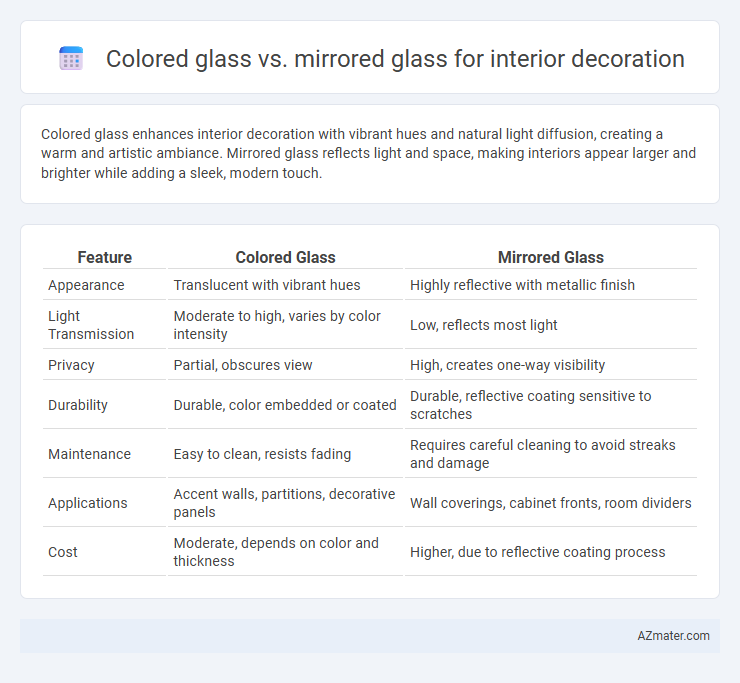Colored glass enhances interior decoration with vibrant hues and natural light diffusion, creating a warm and artistic ambiance. Mirrored glass reflects light and space, making interiors appear larger and brighter while adding a sleek, modern touch.
Table of Comparison
| Feature | Colored Glass | Mirrored Glass |
|---|---|---|
| Appearance | Translucent with vibrant hues | Highly reflective with metallic finish |
| Light Transmission | Moderate to high, varies by color intensity | Low, reflects most light |
| Privacy | Partial, obscures view | High, creates one-way visibility |
| Durability | Durable, color embedded or coated | Durable, reflective coating sensitive to scratches |
| Maintenance | Easy to clean, resists fading | Requires careful cleaning to avoid streaks and damage |
| Applications | Accent walls, partitions, decorative panels | Wall coverings, cabinet fronts, room dividers |
| Cost | Moderate, depends on color and thickness | Higher, due to reflective coating process |
Introduction: Colored Glass vs Mirrored Glass in Interior Design
Colored glass enhances interior design by introducing vibrant hues and dynamic light effects, creating personalized ambiance and artistic focal points in spaces. Mirrored glass reflects light and surroundings, amplifying spatial perception and contributing to a sleek, modern aesthetic. Choosing between colored and mirrored glass depends on the desired psychological impact, light manipulation, and style preferences in interior decoration.
Aesthetic Appeal: Colorful Vibes or Reflective Elegance
Colored glass offers a vibrant aesthetic appeal by introducing rich hues and artistic patterns that enhance interior spaces with colorful vibes, making rooms feel lively and dynamic. Mirrored glass contributes reflective elegance by amplifying natural light and creating the illusion of spaciousness, adding a sleek, modern sophistication to interiors. Choosing between these options depends on whether the desired effect is vivid artistic expression or understated, light-enhancing refinement.
Light Manipulation: Diffused Color or Amplified Brightness
Colored glass in interior decoration diffuses natural light, casting vibrant hues that create a warm and inviting atmosphere while reducing glare. Mirrored glass amplifies brightness by reflecting both natural and artificial light, enhancing spatial perception and making rooms appear larger and more open. Choosing between colored and mirrored glass depends on the desired lighting effect: diffused color evokes mood and ambiance, whereas mirrored surfaces intensify light and visual depth.
Space Enhancement: Visual Enlargement vs Vibrant Accents
Colored glass in interior decoration offers vibrant accents that introduce rich hues and dynamic light reflections, adding depth and personality to spaces without altering spatial perception. Mirrored glass enhances spatial perception by visually enlarging rooms through reflection, creating an illusion of greater depth and brightness that amplifies natural and artificial light. Selecting between colored and mirrored glass depends on prioritizing either bold color integration or visual space expansion to achieve the desired interior ambiance.
Privacy Features: Opaque Hues or Reflective Shields
Colored glass offers opaque hues that enhance privacy by diffusing light and obscuring visibility while maintaining vibrant interior aesthetics. Mirrored glass provides reflective shields that block interior views, allowing natural light to enter without compromising confidentiality. Both options balance privacy and light transmission, with colored glass delivering subtle concealment and mirrored glass ensuring stronger visual barriers.
Maintenance and Durability: Cleaning Colored vs Mirrored Glass
Colored glass requires gentle cleaning with non-abrasive, pH-neutral solutions to preserve its pigmentation and prevent surface damage, and its durability depends on the quality of the color treatment and glass thickness. Mirrored glass demands careful maintenance to avoid scratching the reflective coating; using soft cloths and mild cleaners protects the mirror's surface and maintains its reflective clarity. Both types benefit from routine dusting and avoiding harsh chemicals, but mirrored glass often shows smudges and wear more quickly, necessitating more frequent cleanings in high-use areas.
Cost Comparison: Budget Considerations for Each Glass Type
Colored glass generally offers a more affordable option for interior decoration due to its simpler manufacturing process and widespread availability, making it suitable for budget-conscious projects. Mirrored glass tends to be more expensive because of its additional reflective coating and higher production costs, which also require careful handling and installation to avoid damage. When considering cost-effectiveness, colored glass provides versatile design options with lower upfront expenses, whereas mirrored glass adds luxury and light-enhancing properties but at a premium price point.
Versatility in Application: Where Each Glass Excels
Colored glass offers exceptional versatility in interior decoration by providing vibrant hues that enhance walls, partitions, and furniture, creating a dynamic and artistic ambiance suitable for residential and commercial spaces. Mirrored glass excels in maximizing spatial perception and light reflection, making it ideal for small rooms, hallways, and bathrooms where visual expansion and brightness are priorities. While colored glass adds warmth and personality through its spectrum of tones, mirrored glass contributes to sleek, modern aesthetics by amplifying natural and artificial light.
Combining Colored and Mirrored Glass: Design Harmony
Combining colored glass and mirrored glass in interior decoration enhances design harmony by balancing vibrant hues with reflective surfaces that amplify light and space. Colored glass introduces depth and artistic flair, while mirrored glass adds brightness and a sense of openness, creating a dynamic interplay that elevates aesthetic appeal. Using these materials together allows for customized visual effects, making interiors both visually captivating and functionally elegant.
Choosing the Best Fit: Factors to Consider for Your Space
Colored glass enhances interior decor by adding vibrant hues and creating a warm, inviting atmosphere, ideal for accent walls and partitions in living rooms or offices. Mirrored glass expands space visually and increases light reflection, perfect for smaller rooms or areas needing brightness and a modern aesthetic. When choosing the best fit, consider factors such as natural light availability, desired ambiance, color coordination with existing decor, and maintenance requirements to ensure functional and aesthetic harmony in your space.

Infographic: Colored glass vs Mirrored glass for Interior decoration
 azmater.com
azmater.com